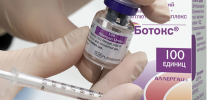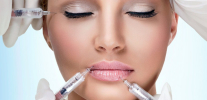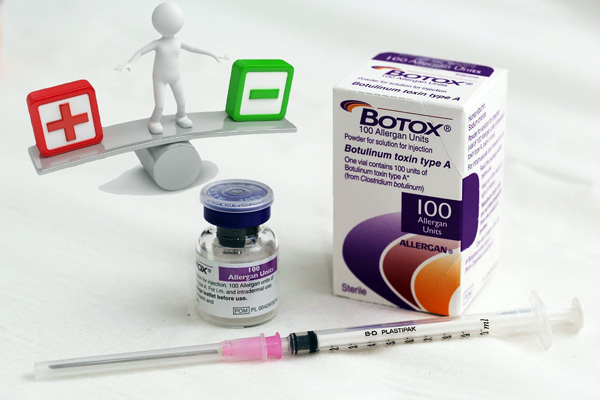
It is widely believed that Botox does more harm than good. Like, how effectively botulinum toxin preparations eliminate wrinkles, how much they harm the body. And when a person learns about the real advantages of “beauty injections”, he often begins to think that they are not saying anything about the attendant disadvantages.
Indeed, people can be understood. On the one hand, botulinum therapy allows you to quickly, literally within a few hours, get rid of deep facial wrinkles, which no other means can cope with. On the other hand, it is logical to expect that, having such a powerful effect, the administered drug should have some serious side effects, no less strong and noticeable.
When people find out that for the most part the “side effect” of using Botox is limited to swelling and bruising on the face that lasts for 2-3 days, it seems to them that they are hiding something, that such a powerful remedy should be more harmful. And, trying to find confirmation of their fears, they discover a lot of different myths about botulinum toxin, more and more reinforcing them in this opinion.
For example, there is an assumption that the use of Botox and its analogues is fraught with the development of cancerous tumors. It is also said that botulinum toxin preparations are addictive and make a person an “addict” who is physically in need of injections. There are many such myths: the risk of poisoning, the weakening of intellectual abilities, skin aging - you will not list all.
But you can figure out the basic myths and find out whether they are justified, whether the things that are reported in them are really dangerous, or nothing more than “horror stories”. And at the same time, to find out what harm the botulinum toxin preparations have for the body has indeed been confirmed and what is really worth fearing.
So, let's try to reveal the whole truth about Botox and its analogues ...
The benefits of botulinum toxin injections in cosmetology and medicine
First of all, we say that the main task of botulinum toxin preparations in general and Botox in particular is not the elimination of wrinkles. Initially, Botox and its main analogues - Xeomin, Dysport, Mioblok - were developed not for cosmetology, but for medical use.
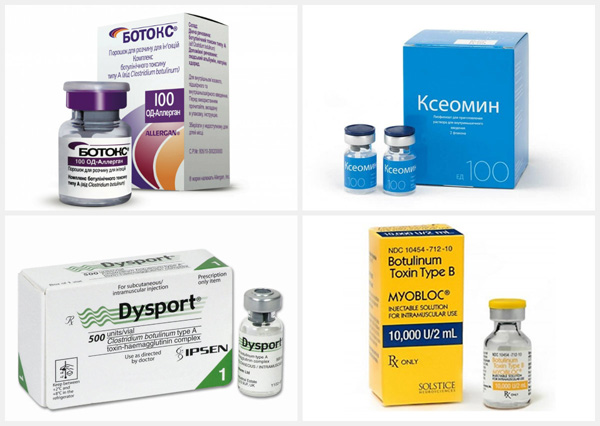
Botox and its analogues.
They, for example, are used to treat:
- Hemifacial spasm;
- Blepharospasm;
- Cervical dystonia;
- Overactivity of the bladder detrusor muscle and associated urinary incontinence;
- Hyperhidrosis of the armpits and palms;
- Cerebral palsy;
- Migraine;
- Wrist spasms in patients after a stroke.
Moreover, in many cases there are no full-fledged alternatives to botulinum toxin preparations for the treatment of these syndromes, and the combination of useful properties and side effects of these drugs is unique: before launching on the market and the beginning of widespread medical use, these drugs were carefully studied in laboratories, and then were limitedly tested on volunteers, while it did not become clear that the benefits of them far exceeded the possible harm. Moreover, this harm should not be equated with dangers - it is, rather, small temporary side effects that do not pose a serious threat to the patient, and even more so they are insignificant in comparison with those diseases that Botox manages to treat.

Botulinum toxin injections can treat excessive sweating.
As a matter of fact, it was due to such high safety that Botox opened the way to cosmetology clinics, which allowed it to become so popular.If he posed a threat to health, using it to improve his appearance would be considered inappropriate, and the drug itself would remain a purely therapeutic agent that would be used only according to strict indications and only in cases where its intended benefit would exceed the possible harm.
But Botox, one might say, was lucky: there were no serious dangers that posed a threat to the patient, and therefore the opinion of all specialists - and neuropathologists, cosmetologists, and scientists - was the same: pricking it for cosmetic purposes is possible and for health it is not harmful, with rare exceptions.
Authentically recorded real dangers of Botox
For definiteness, we distinguish between the terms “danger” and “harm”. We consider as hazards those possible phenomena that pose a threat either to a person’s life or to his health in the long term, that is, they can lead to chronic diseases or disability. By harm, we mean such consequences that are either insignificant in scale of their manifestation and do not worsen the general condition of a person, or such deterioration is temporary, quickly disappears and is not complicated.
The only reliably confirmed serious danger of Botox injections is allergy. In the entire history of the use of botulinum toxin preparations, about 30 deaths have been recorded due to anaphylactic shock when the drug is administered.
In this case, an allergy develops in the same way as with the use of any other drugs or the ingestion of other allergens (for example, with stings of stinging insects).
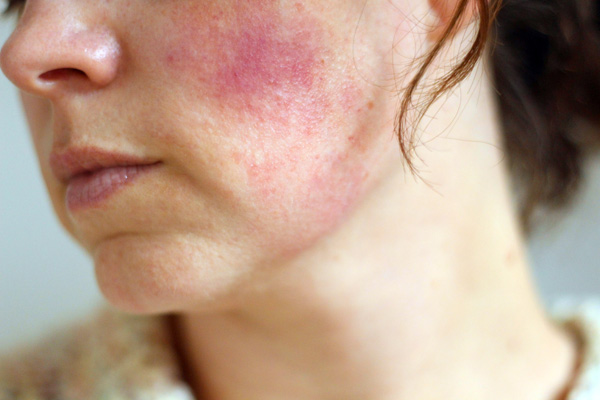
Some patients may develop an allergic reaction to drugs containing botulinum toxin.
On the one hand, the risk of death is very serious, and no cosmetic results are worth the risk of life.
On the other hand, allergic reactions with the introduction of Botox are very rare. Over the entire history of its use, tens of millions of people (including children over 2 years old) have taken advantage of it more than a billion times in total. With such a number of applications, several dozen cases of allergies are an insignificant figure. There are more episodes of allergies with anaphylaxis to dental painkillers, but this is not a reason for their cancellation and surgery on the teeth without anesthesia.
In general, an allergy is never the reason for refusing a particular medicine if its frequency does not exceed the average statistical value, that is, the drug itself is not a strong allergen. Botox and other botulinum toxin preparations do not belong to strong allergens and therefore are by default allowed for use by people who do not have other contraindications.
With a slight stretch, the dangers of using Botox include very rarely manifested side effects:
- Diplopia - double vision, developing due to disruption of the circular muscle of the eye with errors in the work of a cosmetologist;
- Complete immobilization of the circular muscle of the eye with subsequent inability to close the eye. This is fraught with draining the cornea and therefore requires a constant instillation of moisturizing drops until the Botox effect is complete;
- Dysphagia is the inability to make a swallowing movement. It sometimes develops with injections in the neck (for example, when removing wrinkles on the neck or in the decollete) and diffusion of the drug into the muscles responsible for swallowing.

Very rarely, the use of Botox can lead to diplopia (double vision).
All these consequences develop very rarely. Although they are confirmed by cases and special studies described in practice, they are not considered critical: they do not pose a threat to life and, in general, can be stopped by additional procedures.
On a note
An important point in this case is that the frequency of these side effects (except for allergies) largely depends on the professionalism of the doctor and, as a consequence, on the cost of the procedures themselves. Therefore, turning to a truly reputable clinic, you can minimize the risk of such harm to health.
Possible side effects that do not pose a health hazard
Many side effects of botulinum therapy cannot be called harm, since they do not affect health.
Perhaps the only exception to this rule is the respiratory syndrome that sometimes develops after the procedure. Symptomatically, it resembles a typical SARS, only rather weak, with a slight increase in temperature, nasal congestion and sore throat. Typically, these phenomena disappear in 2-3 days without special treatment, are not complicated at all, and are not dangerous.
It is extremely rare for individual patients to form scars at the injection site. This is due to the specifics of skin healing and occurs most often in people who are prone to keloid scarring. Botulinum therapy is contraindicated for them.
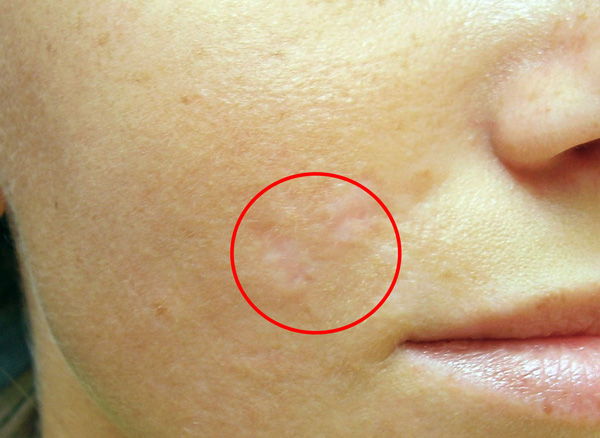
A possible side effect after the use of Botox may be keloid scarring of the skin at the injection site, but only in patients whose skin has exactly this specific healing.
Other undesirable consequences of Botox injections can be attributed to temporary specific manifestations rather than harmful factors. This is for example:
- Cosmetic defects associated with the specific action of the drug in case of its incorrect administration. These include, for example, excessive raising of the corners of the eyebrows ("Mephistopheles' eyebrows"), drooping of the corners of the lips, the formation of the brow and the roughening of facial features, partial or complete ptosis (drooping of the eyelids). All of them do not pose a threat to health, but spoil the appearance;
- Edema, bumps, hematomas at the injection site. They often appear and are considered the norm, completely disappear within 1-3 days after the procedure;
- Unnatural facial expressions, in the most severe cases, creating the impression of a mask on the face (this consequence is also called a “wax face”). As a rule, this defect is associated either with an excessive amount of botulinum toxin introduced, or with an incorrect choice of injection sites. In general, it is difficult to draw a clear line between a positive and an undesirable result, since the absence of wrinkles in expressing certain emotions is unnatural in itself, and therefore even the result that is followed by a cosmetologist can already be considered a deviation from the norm;
- Asymmetry of the face: if a particular defect appears only on one side, or on one side it is more pronounced;
- Pain and itching at the injection site are normal and often manifested effects that pass quickly and do not pose any threat to health.
For example, in the photo below - an example of excessive Botox administration, in which the face statically looks normal, but when expressing emotions, the immobility of individual muscles rushes into the eyes:

This is bad for Botox - when it is used, in any case, to one degree or another, the natural facial expression is violated. Therefore, in cosmetology it is used when such a violation of natural facial expressions is much less noticeable than the absence of wrinkles.
The most dangerous areas, with Botox injections in which the likelihood of complications is highest, are the areas around the eyes and around the lips. There are a lot of small muscles that, due to the individual characteristics of the anatomy of the face, may not be located where they are located in most people, and the doctor has a great risk of mistakes in the injection site, even with high professionalism.
These are the consequences that are documented according to the results of research by scientists and reports of practicing doctors and cosmetologists.However, there is a whole group of imaginary dangers that visitors of cosmetology clinics scare each other with for one purpose or another without goals at all.
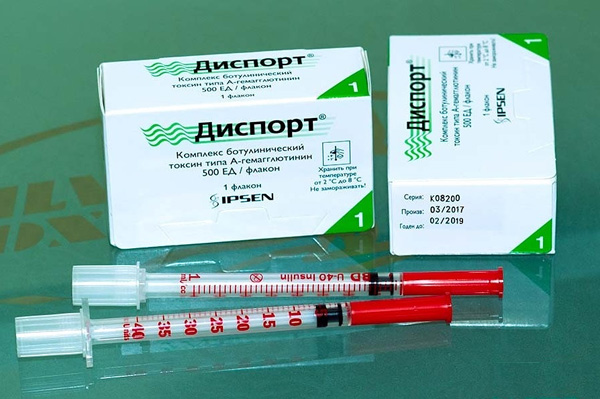
It is believed that Dysport is preferable to pricking girls and young women whose wrinkles are not so deep.
Feedback
Probably, ladies under 40 will be surprised, but I’m stabbing Dysport for the second time, and I’m only 26. Alas, oh, I have too expressive facial expressions, too often I am in the fresh air, I wrinkle too often. As a result, already at 25 she found creases between her eyebrows, crow's feet in the corners of her eyes and wrinkles under her eyes. Panicked. I went to the beautician. They reassured me there, they said that there was nothing critical, but in general there was a problem and it needed to be fixed. Immediately signed a contract, went to prick. Agreed on Dysport. For those who are not in the know, I’ll explain. This is a complete analogue of Botox, only French, with a milder effect. It is just applied when the wrinkles are still not deep, and the skin is young.
It works the same botulinum toxin type A, which is used in cosmetic medicine in other means, in the same Botox. I was injected with only 8 units - two in between the eyebrows, two in the corners of the eyes and one under each eye. This is very little in fact, because women under the age of 40-50 are injected up to 50 units at a time. But enough, thanks to the doctor. The procedure itself cannot be called pleasant - the smell of the clinic, the doctor in a white coat, a hefty syringe with a thin needle. But generally tolerant. What I did not like after use - my head hurt a lot. I even wanted to drink painkillers, but the doctor dissuaded me, said that it would be normal and quickly pass. Indeed, the morning after sleep passed. With wrinkles. Yes, all wrinkles have disappeared. It is clearly visible that the skin relaxed. The face became clean, although it seems a little that when I smile or get angry, somehow everything is unnatural. But the benefits outweigh. What is the result: Dysport lasted 4 months, then had to be repeated. Others stay longer, but I drank alcohol on holidays, and this affects the duration. I feel that I'm hooked on him. It seems that there is no dependence, but I only see wrinkles, I have no doubt - you need to run to stab. After the second time I didn’t do it for a year and a half, because I was planning a pregnancy, and then I became pregnant. But now, as soon as breastfeeding ends, I’ll go to inject. I can’t look at these wrinkles anymore.
Nina, Moscow
Myths about the dangers of botulinum toxin preparations
It is known that danger is much easier to declare than to acknowledge. At the same time, a statement of danger can easily undermine the reputation of a therapeutic (including cosmetic) tool or method, but the refutation of this information requires considerable effort and financial cost.
For example, there is nothing easier than telling friends that Botox causes cancer. And while referring to information from the Internet. Fortunately, on the Internet such statements are just as easy to find. Acquaintances will tell acquaintances, those about theirs, and a whole group of people has already formed who are sure that after botulinum therapy they are most likely to get cancer. Therefore, they will refuse the procedure itself.
At the same time, there are no grounds for such allegations. No one has demonstrated the relationship between Botox injections and the development of cancer; there is also no theoretical justification for such a connection. - that is, neither specialists nor anyone else can explain how exactly botulinum toxin can provoke the development of a cancerous tumor. Statistics show that the frequency of cancer among those who injected Botox and those who did not undergo such procedures is the same, including in the long term - several years after the procedure.
Therefore, Botox does not cause cancer.This is a myth, which, however, is not officially debunked, since there is no need for such debunking. If there is no reason to suspect that botulinum toxin may be a carcinogenesis factor, there is no need to dispel such suspicions.

It is important to know that there is absolutely no connection between botulinum therapy and cancer.
Another widespread concern regarding Botox and its analogues is based on the fact that botulinum toxin, as a powerful nerve poison, can cause poisoning. And often, reporting such a danger, they say that with intoxication the liver and brain are affected.
This is a typical fallacy that has nothing to do with reality. Botox and other similar drugs, in fact, contain botulinum toxin, which is the strongest natural poison. However, its amount in the administered drug is so small that it is not able to have a toxic effect on the body. In addition, with injections, the drug is injected into the target muscles and in them it is completely distributed in the cells. Poisoning can occur if significantly larger amounts of this substance enter the digestive tract, and from it into the blood. Since Botox is not taken by anyone, a systemic effect on the body and poisoning by it is impossible.
These are the most common myths. Less commonly (but still quite often), there are also such:
- Botox reduces the human intellectual ability. They substantiate this point of view by the fact that, like a neurotoxin, it supposedly acts specifically on the nervous system, the central organ of which is the brain. Therefore, just as a remedy disrupts the innervation of muscles, it disrupts mental activity. In fact, nothing of the kind can happen in principle, since after injection the drug does not spread in the nervous system beyond the junction of the nerve endings with muscle fibers. Botox is not able to get into the brain, nor can it affect it (unless, of course, we are talking about intramuscular injections);
- Botox is addictive - another myth. It is refuted by the same arguments as the previous one: since botulinum toxin preparations do not affect the brain, they cannot cause mental dependence. Physical dependence is also impossible, since these funds do not have any effect on the functioning of internal organs;
- As a result of supposedly addictive, to obtain the full effect of each of the following procedures, increasing quantities of the drug are required, which sooner or later will lead to poisoning. In fact, since there is no addiction to botulinum toxin, increasing dosages is not required. However, taking into account the fact that over time, no one person physically becomes younger, it will be obvious that from the beginning of the use of Botox, the number of wrinkles and their depth in patients gradually increase. Therefore, to eliminate defects every time requires more and more quantities of funds. But such an increasing need does not depend on the action of the drug itself;
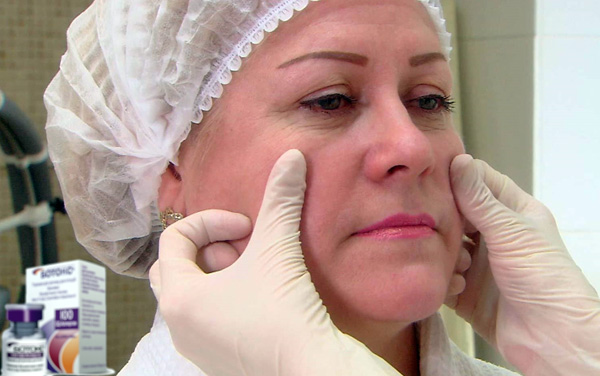
As the patient ages, the number of units of botulinum toxin needed to achieve the desired effect also increases.
- Botox accelerates skin aging. The reason for the appearance of this myth is the same as the previous one. Each new botulinum treatment procedure is carried out six months to a year after the previous one, and the vast majority of cosmetologist patients are women older than 35 years. It is clear that, for completely natural reasons, a woman’s skin will not become younger and healthier in six months. But it is a mistake to believe that Botox is responsible for such aging - it has nothing to do with the condition of the skin, and by reducing its dynamic mobility it even reduces the load on the skin and, therefore, slows down their aging.
The truth is that almost always opinions about Botox's harm in the long run are erroneous. Just as this remedy cannot completely and permanently eliminate a cosmetic defect, it is not capable of causing significant harm to the body.
Finally, the exorbitantly hyped fears of visitors to cosmetology clinics deserve to be mentioned, in which the results of the procedures did not meet expectations. For example, it happens that a woman expects to immediately leave the office with a perfect face and without a single wrinkle. And then he comes home, looks in the mirror, sees edema, redness and a wrinkle that has not yet been completely gone - and begins to panic. After 2-3 days, all these consequences go away, and the wrinkle disappears with them, but during this time the client has time to write dozens of angrily scared messages on the forums, several negative reviews on specialized sites, phoning all her friends and advising them to put Botox on them. And sometimes, it even comes to additional procedures to eliminate the effects of botulinum therapy.

Sometimes patients who expect an immediate result after botulinum therapy are disappointed by what they see and immediately start complaining about the inefficiency of “beauty injections”.
After a couple of days, everything goes away, the face becomes clean and smooth, wrinkles disappear, but the reviews are already written, cosmetologists are cursed, the harm of the drug has been confirmed by dozens of face shots from different angles posted on all available sites and social networks.
In truth, about half of all Botox harm stories come from just such situations. About as many people still have the opinion that any botulinum toxin preparation is harmful, is formed only because they became a victim of an amateur cosmetologist.
Dangers associated with the misuse of Botox
Indeed, the consequences of incorrect Botox administration can be, if not dangerous, then extremely unpleasant for the patient. At least with the cosmetologist’s mistakes, the result is the opposite of what you wanted: if initially the task was to eliminate wrinkles, as a cosmetic defect, then if the drug is injected incorrectly, wrinkles are often replaced by more pronounced and unsightly defects.
Due to the incorrect dosage of the product or errors in the choice of points of administration, the following are possible:
- Ptosis, both full and partial;
- The omission of the corners of the lips, both symmetrical and asymmetric;
- Raising eyebrows;
- The formation of the superciliary roller, creating the impression of a rough face;
- The formation of compensatory wrinkles that occur in places where the skin is squeezed by facial muscles that were left without active antagonists;
- "Wax face" on which emotions are lost due to the immobility of the muscles.
In fact, there are many such defects. They do not pose a threat to health, but visitors to cosmetology clinics may fear them more than the true harm to the body, because these shortcomings are very noticeable and immediately catch your eye.
For example, the photo below shows a typical example of Mephistopheles eyebrow:
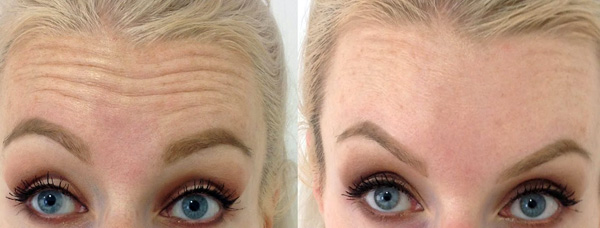
Agree, for the sake of getting rid of wrinkles, putting yourself at risk of getting such a “beauty” is at least unreasonable.
On a note
The appearance of the superciliary roller is a drawback only from the point of view of women. Some men inject Botox into the forehead, including in order to form such a roller and look more masculine and severe.
You must also understand that often undesirable consequences from the use of botulinum toxin are manifested through the fault of the patient himself, who violated the rules of the rehabilitation period. Such rules are numerous and quite strict, people often violate them (sometimes without even knowing about them), as a result of which side effects develop with varying frequency.As a rule, they are associated with the diffusion of botulinum toxin into non-target muscles, due to which not only muscles whose contraction leads to the formation of wrinkles are immobilized, but also those that are not connected in any way with wrinkles. Moreover, the more muscles are exposed to Botox, the greater the likelihood of a particular defect.
Such consequences can lead, for example, to drinking alcohol after the procedure, intense physical exertion, going to the bathhouse or to the beach within 2-3 days after the introduction of Botox, and other cosmetic procedures. Therefore, the doctor’s instructions for the rehabilitation period should be treated very responsibly.

During the rehabilitation period after botulinum therapy, you must strictly adhere to the doctor's recommendations in order to avoid side effects.
Feedback
I am now categorically against Botox. Pricked once, walked like a plastic doll for six months. It seems that you are smiling, but nothing changes on your face, only your mouth is ajar. There is no particular harm, there were no bruising-bruises, but the effect itself is terrible. I don’t know, maybe I just got unsuccessfully injected, but I didn’t like it at all. After that I did a call, I go for a peeling, and, in principle, I have enough. Wrinkles, of course, do not completely go away, but they look natural and good. This is more useful than injecting poison. And when you look at the news about this fake Botox, you understand that it still needs to be lucky so that the drug is normal and all its advantages are manifested. Moreover, I constantly take contraceptives, and, they say, they can somehow interact poorly with Botox. In general, so.
Eugene, Kazan
Research results
All botulinum toxin preparations, including Botox, Dysport, Xeomin and others, undergo many clinical trials before being launched to the market to confirm the effectiveness and safety assessment of each drug.
All these studies have shown high safety of drugs when introduced into skeletal muscle, including the facial muscles.
For example, in Botox studies, the incidence of side effects was 7%, and most often a headache was manifested from such effects. The incidence of ptosis or diplopia was less than 1%.
And, for example, in studies of Dysport, ptosis and diplopia did not appear at all. In this regard, some authors make the assumption that, possibly, diplopia and drooping of the eyelids arise due to the mistakes of cosmetologists. Since only highly qualified specialists take part in the studies, and the procedures themselves are carried out quite conservatively, the possibility of error here is practically excluded.
During studies of Relatox (an analogue of Botox made in Russia) and analysis of patient reviews of this drug, it was noted that its administration is often accompanied by pain, the appearance of bruises and swelling. For Botox itself, these side effects are much more rare.
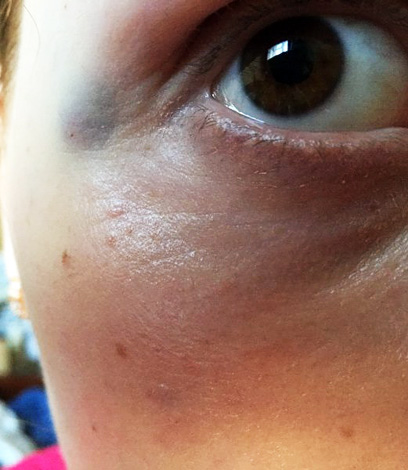
Most often, side effects in the form of swelling and bruising are observed after the use of Relatox.
In general, the differences in the safety profiles of different botulinum toxin preparations are small, and it is impossible to say that Botox is less harmful than, for example, Dysport. Even if the likelihood of side effects when using these agents varies, these differences are very small and are offset by risks associated with the human factor - doctor’s errors or patient irregularities. Therefore, in general, when choosing a drug, you can not pay attention to its safety profile.
Fake Botox
Another thing when it comes to fakes under Botox, Xeomin or other drugs. Such counterfeit today literally floods the market because of the high demand and interest in dishonest businessmen (including individual clinic owners), but no one can say for sure how dangerous such counterfeit funds are.
At a minimum, fake products are almost always made with less thorough cleaning than the original ones. This means that such a drug is more likely to cause allergies, pain at the injection site, edema and other undesirable consequences.
Worse, if the fake either does not have botulinum toxin at all, or it is contained in very small quantities. In fact, injecting it will be equivalent to injecting distilled water. Which, incidentally, does not mean safety - the introduction of fluid into the muscles can lead to extensive edema with their further preservation and the formation of dense cones.
More dangerous consequences of using counterfeit products are:
- Rejection of the drug, the development of an inflammatory reaction and ulcers in the places of its introduction;
- Necrosis of injected tissue;
- Scar formation at the injection site;
- Unnatural skin pigmentation.
It is impossible to predict in advance what these consequences will be, since the composition of the fake is never known.
At the same time, many doctors use counterfeit Botox without even knowing it. They work with the tool that the clinic gives them, and already the purchasers find such “ideal” fakes that are almost impossible to distinguish from the original in appearance.
This is another reason not to chase the cheapness of services and go to clinics that value their reputation and offer botulinum therapy at reasonable prices.
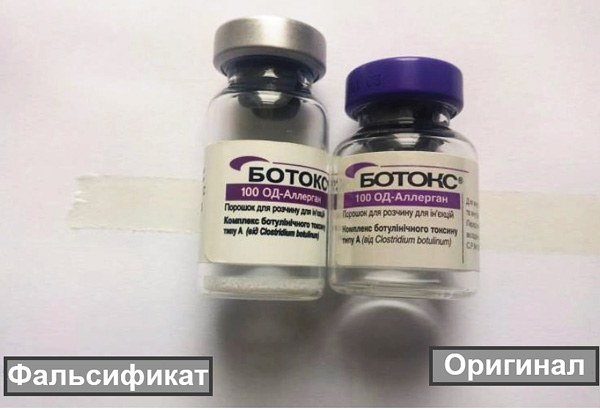
It is sometimes difficult to distinguish a fake drug from the original. Only a professional who is engaged in botulinum therapy will be able to determine falsification by external signs.
Five simple tips to minimize your risks.
What to do to reduce the risk of undesirable consequences of botulinum therapy and undergo this procedure without harm to health? There are 5 basic rules that in most cases will help to avoid dangers.
First: carefully choose a doctor and clinic. Focus primarily not on aggressive advertising and reviews on forums, but on the opinions of friends who have already gone through the procedure and got the result. If the doctor of your choice made the injections correctly and with the desired effect, do not change it without urgent need.
Second: strictly follow the doctor’s instructions, even if they seem redundant to you. All these rules are written on the basis of information about the causes of undesirable consequences in other patients, and ignoring them is a direct way to repeat someone's failure.
Third: do not pursue cheapness and economy. Discounts, promotions, “sensational” offers are due either to the cheaper work of the doctor, or to the reduction in the cost of the drug. Both behind it, and behind another there may be an increased risk of dangerous effects.
Fourth: discuss any problems and issues with the beautician, in no case trying to solve them yourself. This will help you not to worry when there is no reason to be worried, and to solve the problem quickly and efficiently, if one really appeared.
And fifth - do not panic ahead of time. Remember that according to statistics, approximately every fourteenth visitor to the cosmetology clinic develops certain side effects, but according to the same statistics, most of them completely disappear 2-3 days after the appearance. Call a doctor, describe the situation, calm down, take a sick leave at work and rest for two days. And then shine without any traces of botulinum therapy, and without wrinkles on the face.
An interesting video about the pros and cons of botulinum therapy
Complications after the introduction of Botox. Why not be afraid?

